#native aotearoa fauna and flora
Text

Kākā enjoying Kōwhai flowers in a vaguely Frances Hodgkins' style.
281 notes
·
View notes
Text
Having thoughts and feelings about the fact that Ed is barefoot throughout the whole storm sequence and what follows.

Before they go on deck and see him destroying everything, Frenchie said Ed wanted to "spend some more time with nature". While it's very common to go barefoot in AoNZ, there's also a cultural connection of getting physically in touch with the land you're standing on and where you come from.
And then it carries over to his own purgatory: he's walking barefoot in a landscape that is 100% Aotearoa. The beaches, the animals and plants are all native fauna and flora, the birdsong we hear is all local birds, the ingredients for a traditional Māori boil-up, the basket and sandals all familiar parts of his heritage.
There's something about this man who had to leave his home - his whenau - when he was so young and who has lived through so much and it's still where his mind takes him when he's on the brink of death, with one foot - as they say - in the grave.

191 notes
·
View notes
Text

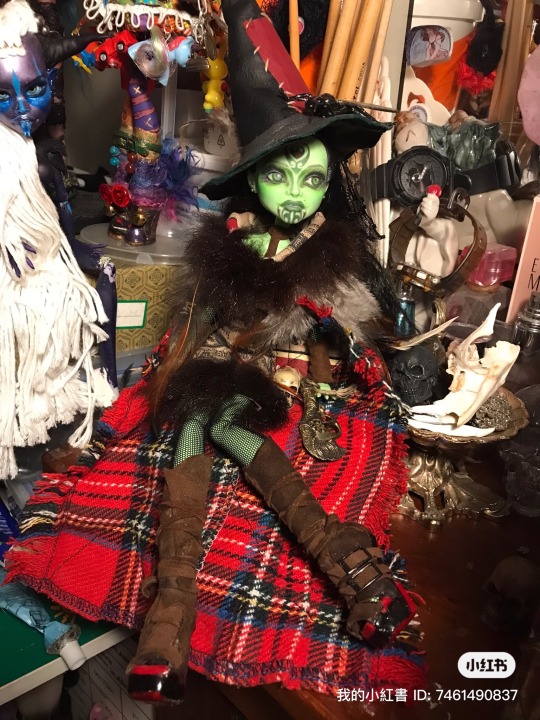

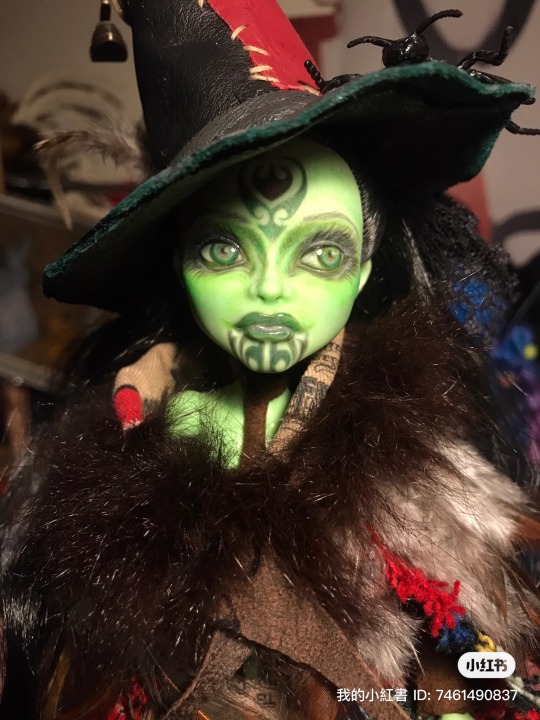





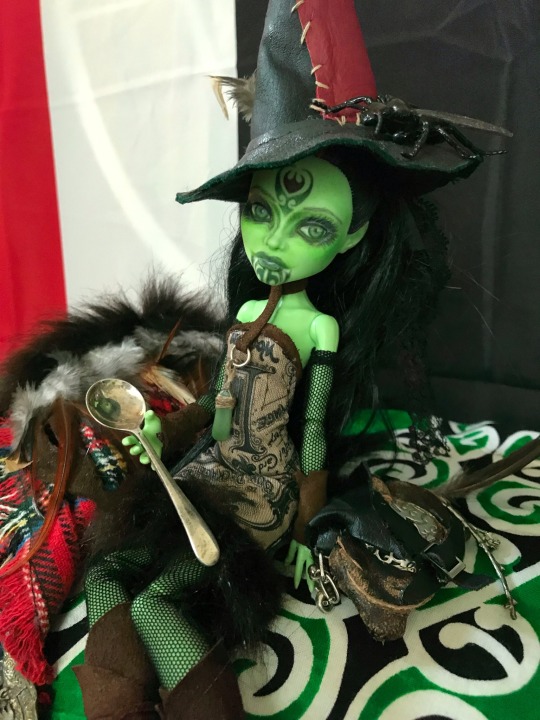
monster high casta fierce repaint
This Doll is made in inspiration of my country and our native people and its mythology and beliefs including our wildlife flora and fauna~
Meet Ngarara Kai wairua Ngahere Tohunga
Native Hybrid Witch spirit eater custom doll
So shes part maori (my culture ethnicity)part taniwha & part demi goddess her tipuna are from a long line of Tohunga.. she has been around for 100s of years she is lives in the time of jst after settlers arrived in Aotearoa..Even so her magic enables her to travel back & forth in time so she has abundant knowledge of many people & things,she prefers her own era of the 1800s... she carries her potion spoon her red Tiki magic Rakau (wand) and her bottemless bag of magic,not to be trifled with she will also eat you for dinner if shes crossed..,its her lizard lineage that makes her ferral that way..
shes looking for a new whare(home) to watch over...
#custom dolls#art dolls#plastic and vinyl dolls#dolls#dollblr#doll clothes#dollcore#ooak dolls#monster high custom#custom monster high doll#ooak monster high#casta fierce#doll repaint
10 notes
·
View notes
Text
Aotearoa Conservation Week is Sep 4th-12th in 2022!
Aotearoa New Zealand has a high level of endemic biodiversity with an estimated 80,000 species of native animals, plants and fungi. Endemic species examples include all the frogs and reptiles, more than 90% of the insects, approximately 80% of vascular plants and a quarter of bird species. In the last 1000 years, 40 indigenous land and marine species have become extinct. The most recent inventory identified 799 threatened species and 2,741 at risk species.
New Zealand has 425,000 kilometres of rivers and streams, almost 4,000 lakes larger than 1 hectare in surface area and about 200 groundwater aquifers. Current data indicate that only around 10% of New Zealand’s original wetland systems remain, covering approximately 249,776 hectares.
Agriculture occupies about half of the total land area of New Zealand, mainly on the relatively fertile lowlands. Indeed, there is less native vegetation remaining in lowland areas. Broadleaved native hardwoods, mānuka and/or kānuka, and tall tussock grassland have experienced the greatest losses. New Zealand’s indigenous forests cover 7.2 million hectares which is about 24% of the land area. (sources)
Here's some cool causes that can be supported:
Kea Conservation Trust fundraiser (Assists in the conservation of wild Kea (Nestor notabilis) in their natural habitat and aims to increase the husbandry standards and advocacy potential of those Kea held in captive facilities within New Zealand).
Te Kakano Aotearoa Trust (Te Kākano Aotearoa Trust is a Wānaka community-based native plant nursery that specialises in propagating plants of local origin (Upper Clutha region) and uses these plants for localised native habitat restoration).
Motu Kaikoura Trust (564-hectare island is now an open sanctuary for native flora and fauna and is subject to continuous pest control, with an aim to support the natural regeneration of the vegetation-free of invasive plants and animals).
Bushy Park Sanctuary (The 98-hectare sanctuary is a haven for endangered wildlife, with successful reintroductions of toutouwai (North Island robin), tīeke (saddleback) and hihi (stitchbird). Donations help support the biodiversity and biodiversity work for the sanctuary and our education programme).
Aongatete Forest Restoration Trust (Focused on restoring 500 hectares of native forest in the Kaimai Mamaku Forest Park, between Tauranga and Katikati).
#got so many plans this conservation week#aotearoa#new zealand#conservation#ecology#environmentalism#climate crisis#taking action
52 notes
·
View notes
Text
I started writing a cute little Fang finds a pubby and Izzy works to convince Ed and Stede to let the pup stay fic just now (literally like five lines in)
And went to research quick what dog breeds were found in Aotearoa going waaaay back (if any bc I know like Aus what animals were already there vs ones brought in and potentially invasive is a Big Thing now and historically to protect native flora and fauna) bc I thought that would be fun for this and I just
I've been met with the saddest pictures of taxidermied dogs that I've ever seen what the actual fuck google like I understand they might be relevant to the topic, but now I'm even more sad!! And you didn't provide me any useful information so I get to keep digging! Thanks! I guess!
#text post#I really get squicked by taxidermy too so my brain is just Shouting rn but it's gonna have to deal#I want fang to have a cool lil pup as a new friend that everyone can welcome onboard#and I want a little historical angle to it bc I think that's fun too#did not Expect That tho and tbh I probably should have but. here we are fuck it we ball let's try and find the info anyway
1 note
·
View note
Text
Being In Aotearoa, Papatūānuku is the earth.
"Whenua in Aotearoa is feminine and her name is Papatūānuku. She exists in almost every culture and manifests under several pseudonyms. In Bolivia, she is ratified and protected by the constitution. The notion of land as feminine has persisted relentlessly throughout history, hand in hand with a colonial desire to claim and subjugate her. As a child, I saw the sinuous curves, danger and beauty of the whenua as evidence of a living, breathing wāhine. Her waist, the crevices and valleys between her hips and bosom, were cinched by years of erosion. The flowering and prospering native fauna and flora spoke to her investment in tikanga; the protection of this taonga ensured her health, sustainable growth and fertility. Her diverse environments co-exist; the dehydrated plains of central Otākou, the salty West coast wind, the glare of the Ahipara sun; were all telling of her fragmented self. Her legs the length of the Waikato River. To speak her name, Papatūānuku, was to taste sea-spray, ochre soil and the shade of a kauri." - Miriama Aoake (Ngaati Maahuta, Ngāti Hinerangi, Waikato-Tainui): writer, critic and postgraduate student in Māori Studies.
I think it would be incredibly ignorant and disrespectful if my research on the landscape, flowers (both introduced and native to Aotearoa) and what is observable in Tāmaki Kakaurua didn't understand through copious acknowledgement of Māori sciences, tikanga and the guidence of local iwi.
from the article "Ko wai ahau? Papatūānuku and I" on The Pantograph Punch, 2017.
"Ko Taupiri te Maunga, Ko Waikato te Awa, Ko Pōtatau te Tangata"
Taupiri is the Mountain, Waikato is the River, Pōtatau is the Man.
"Colonial desecration is defined by the erasure of Te Ao Māori, and the establishment of invasive, foreign boundaries that must fall. Māori understanding of Papatūānuku as a living body comes with an understanding of kaitiakitanga, that she exists alongside Māori, personified in the geographic terrain of Aotearoa. To apply Marama Muru-Lanning’s assertions of landmarks as a living being, “[rivers] were just part of the way we lived, not something to be controlled or owned.”[1]
[1] Muru-Lanning, Marama. ‘The Analogous Boundaries of Ngaati Mahuta, Waikato-Tainui and Kiingitanga. University of Auckland. Pages 9 - 41.
Papatūānuku, against her will, became subject to settler reconstruction. Lisa Taouma purports European interest in the Pacific and her bountiful land is synonymous with the construction of the dusky maiden stereotype, “naive, untouched and passively inviting of Western penetration.” Papa’s autonomy was stolen from her, defiled, devalued and defaced. She was forcibly fragmented by irreversible colonial boundaries, becoming an unwilling subject of the Crown.
The domineering Pākehā hegemony dissolves the importance of the Māori world view within the self to promote a monocultural agenda. Colonial methodology evaporates the visibility of tikanga; manaakitanga, whanaungatanga, kotahitanga, rangatiratanga, mohiotanga, maramatanga, tuakana, kaitiakitanga, atuatanga, wairua and mauri. Resistance is the less desirable, more difficult path to restore the principles of tikanga to reclaim the whenua/body."
‘Ko wai ahau? Who am I?’." -Miriama Aoake
access here: https://www.pantograph-punch.com/posts/papatuanuku-and-i
Saana Murray — and an awakening for a Pākehā by Kennedy Warne, 2016, E-tangata
Kennedy Warne, a co-founder and former editor of New Zealand Geographic and the author of Tūhoe: Portrait of a Nation, on how the cultural sleep was rubbed from his eyes.
"It was 1989. New Zealand Geographic, the magazine I co-founded and edited with the publisher, John Woods, was less than a year old. One of our photographers, Arno Gasteiger, had produced a set of evocative images of the Spirits Bay — Cape Reinga area, and I was keen to publish them but didn't have any text to go with the photos.
A friend suggested Saana Murray, a poet, an elder of Ngāti Kuri, the tribe of that place, and a keeper of the long-burning fires of her people. I asked how soon she could deliver the text. What she told me I have never forgotten. “I cannot write anything here,” she said. “I will have to go to the land.”
She said it as if she were stating the obvious. Yet it was the first time I had heard such a thing: that words about the land required the presence of the land. That knowledge was inseparable from its context.
For someone steeped in scientific thinking — a mindset in which knowledge is a commodity, endlessly transferable — it was a challenging thought. For a moment, the fabric of my fact-based worldview started to fray, and I caught a glimpse of another country.
I‘ve come to learn that this is the country Māori inhabit. In the Māori worldview, context is vital. Knowledge is not disembodied information but part of a living matrix of encounters and relationships, past and present, natural and spiritual.
Tūhoe take this sort of experience in their stride, incorporating it into a life narrative that interweaves many ways of knowing. And, really, this is what Saana Murray showed me all those years ago, when she said she had to go to the place where the knowledge belongs." -Kennedy Warne.
Adding to Warne's comments is
Becoming ‘really Pākehā’ by Jen Margaret, 2019
"The Pākehā nation is an unruly beast. Reflecting on the state of the Pākehā nation is therefore a daunting task that has made me query what the Pākehā nation is, as well as what it might be.
I employ the common usage of Pākehā, which describes the diverse group of people who are white European, particularly of British descent. Our stories prior to arrival in Aotearoa are varied, as are our experiences since arrival. What we have in common is our privilege as beneficiaries of colonisation.
Ani Mikaere (Ngāti Raukawa, Ngāti Porou), a barrister and solicitor and teaches Māori law and philosophy, said:
There is nowhere else in the world that one can be Pākehā. Whether the term remains forever linked to the shameful role of the oppressor or whether it can become a positive source of identity and pride is up to Pākehā themselves. All that is required from them is a leap of faith.
Problematic theories of the inherent superiority of white folk (like the Great Chain of Being), which many Pākehā disavow while holding firmly to patterns of thought which the theories have planted. While often articulated in more subtle ways than in the past, cultural racism — the innate belief that cultures have certain attributes that make some superior to others — is flourishing in Pākehā society.
Within the article, Rebecca Solnit attests that being dominant “means seeing yourself and not seeing others” and how, in this way, privilege limits and obstructs imagination. Winning the colonisation race — the race of cultural dominance — has generated huge imbalance and loss. Māori have been the most devastated, yet Pākehā too have been damaged.
We should teach our colonial history, because we don’t, and this is a huge mistake. You cannot know who you are as a society unless you know your history. Look out across the world and see the extraordinary divisions within societies. Frankly, the rise of white racism is partly because people don’t understand their history. (Jim Bolger)
Pākehā ignorance is coupled with British ways of operating that don’t fit here on Māori land. Re-centring indigenous ideologies is a core dimension of decolonisation.
In the face of climate change and growing inequity, decolonisation is critical to the survival and health not only of indigenous peoples but of us all. "The task of calling things by their true names, of telling the truth to the best of our abilities, of knowing how we got here, of listening particularly to those who have been silenced in the past". (Rebecca Solnit)
0 notes
Text
Elevate Creativity: Art Lesson Plans for Teachers in New Zealand
Unlock the full potential of your students' creativity with thoughtfully curated art lesson plans designed for teachers in New Zealand. These lesson plans go beyond the traditional and embrace the rich cultural diversity and natural beauty that defines the Kiwi experience.
Crafting engaging art lessons allows educators to inspire young minds, fostering a love for creativity and self-expression. Whether it's incorporating traditional Māori art forms, exploring the breathtaking landscapes of New Zealand, or delving into contemporary Kiwi artists, these lesson plans provide a platform for students to connect with their heritage while exploring their own artistic voices.
By integrating art into the curriculum, teachers can enhance critical thinking, problem-solving, and communication skills in their students. From vibrant paintings inspired by the native flora and fauna to collaborative projects celebrating New Zealand's unique cultural tapestry, these lesson plans empower teachers to create a dynamic and inclusive art education experience.
In a country known for its artistic flair, implementing these Art Lesson Plans For Teachers in New Zealand allows educators to nurture the next generation of creative minds. The fusion of cultural richness and artistic exploration in New Zealand's classrooms ensures that students not only develop artistic skills but also gain a deep appreciation for the unique identity and creativity that defines Aotearoa.
0 notes
Text
The Kiwi Craze for Bags: A Glimpse into New Zealand's Bag Culture

Introduction
New Zealand, often referred to as the Land of the Long White Cloud, is known for its stunning landscapes, unique wildlife, and vibrant culture. However, one aspect of Kiwi life that often goes unnoticed is the nation's love affair with bags. From the iconic jute shopping bags to the traditional Māori kete, bags in New Zealand hold a special place in the hearts of its people. In this blog, we'll delve into the fascinating world of bags in NZ and explore their significance in this beautiful country.
Jute Shopping Bags: The Kiwi Icon
One of the most recognizable symbols of New Zealand's bag culture is the humble jute shopping bag. These eco-friendly bags have become synonymous with grocery shopping in the country. Supermarkets across NZ offer jute bags as a sustainable alternative to plastic bags, and many Kiwis can be seen carrying them while doing their weekly shopping.
The popularity of jute bags in New Zealand is a testament to the nation's commitment to environmental sustainability. These bags are not only durable and reusable but also biodegradable, making them an excellent choice for eco-conscious shoppers.
The Māori Kete: A Cultural Treasure
While jute bags may dominate the modern shopping scene, the traditional Māori kete holds immense cultural significance in New Zealand. The Māori people, the indigenous population of Aotearoa (New Zealand), have been creating and using kete for centuries.
Kete are woven baskets or bags made from flax leaves, and they come in various sizes and shapes. They are used for a wide range of purposes, including carrying food, tools, and personal belongings. Each kete is a work of art, often featuring intricate weaving patterns and designs that reflect the Māori culture and heritage.
These beautiful bags are more than just functional items; they are a symbol of Māori identity and craftsmanship. Many contemporary Māori artists continue to create kete, preserving this traditional art form and ensuring that it remains a vital part of New Zealand's cultural fabric.
Kiwi Fashion and Designer Bags
New Zealand has a burgeoning fashion industry, and Kiwi designers are making their mark on the global stage. Bags, as essential fashion accessories, play a significant role in this industry. Local designers create a wide range of bags, from stylish handbags to practical backpacks and everything in between.
Kiwi fashion is often influenced by the country's natural beauty, and you'll find many bags adorned with designs inspired by native flora and fauna. Additionally, New Zealand's commitment to sustainability is reflected in the materials used by these designers, with many opting for eco-friendly and locally sourced materials.
Outdoor Adventure Bags
New Zealand's breathtaking landscapes make it a haven for outdoor enthusiasts. Whether it's hiking in the Southern Alps, kayaking in the Marlborough Sounds, or cycling the Otago Rail Trail, Kiwis love their outdoor adventures. As a result, bags designed for outdoor activities are in high demand.
Specialized backpacks, dry bags, and hiking packs are popular among those who seek adventure in the great outdoors. These bags are designed to withstand the rugged terrain and unpredictable weather that New Zealand has to offer, making them essential companions for any outdoor excursion.
#italian leather handbags#leather bags in new zealand#leather handbag in new zealand#designer leather handbags#handbags#italian leather bags#leather bag
0 notes
Text
Ranger Biodiversity - Department of Conservation - Tongariro National Park
Are you passionate about conservation, with a desire to make a difference protecting Aotearoa’s diverse and unique flora, fauna and iconic landscapes?
Would you enjoy a balance of 40% office-based work and 60% field delivery work in a native bush environment?
Four weeks + three days annual leave per year.
Permanent full-time, Ohakune/Whakapapa offices within the Tongariro District.
Toitū te…

View On WordPress
0 notes
Text
Week 5 Task 2 independent study
- tv ads have subtle racism.
- portray stereotypes.
- Used to create an image of the ideal
or 'cookie cutter' New Zealander.
I found this essay somewhat confusing and difficult to read. It has a lot of information and I was struggling to take it all in. I understand some of what was written how ever I am still confused at who Billig and Anderson are. Because of my confusion I am unable to accurately break this essay down.
I chose the McDonalds 1995 ‘Kiwi Burger’ ad. In the ad they list off ‘kiwi’ things that according to the ad all kiwis love. With in the list are rugby balls, silver ferns, kauri trees, kiwi fruit, gumboots etc. To be a ‘kiwi’ doesn’t mean to love all of the things listed, some of the items within the list are native flora and fauna, these seem to have just been added because they’re native. Not all of the items listed are necessarily just ‘kiwi’ things either such as butterflies and gumboots, they’re a practical shoe but that doesn’t go to say every ‘kiwi’ owns or should own a pair. What angers me about this ad is that the Maori words are not pronounced correctly, in particular the word Maori, if you are going to have indigenous language and/or content in your work it needs to be in appreciation for the culture not appropriation.
The audio is accompanied by many images and videos of the items, actions and other ‘kiwi’ things in their list. The images include Maori art but every person in the ad is white, this is another example of using Aotearoa’s indigenous people as a marketing ploy.
Link to chosen tv ad: https://www.ngataonga.org.nz/set/item/189
0 notes
Text
Today I went out foraging for some Teatree leaves. There is a reserve behind my house close by, that has large diversity of trees and plants and I thought that I may be able to find teatrees.
I luckily was able to! In the centre-ish of the reserve is a healthy grouping of Teatrees.


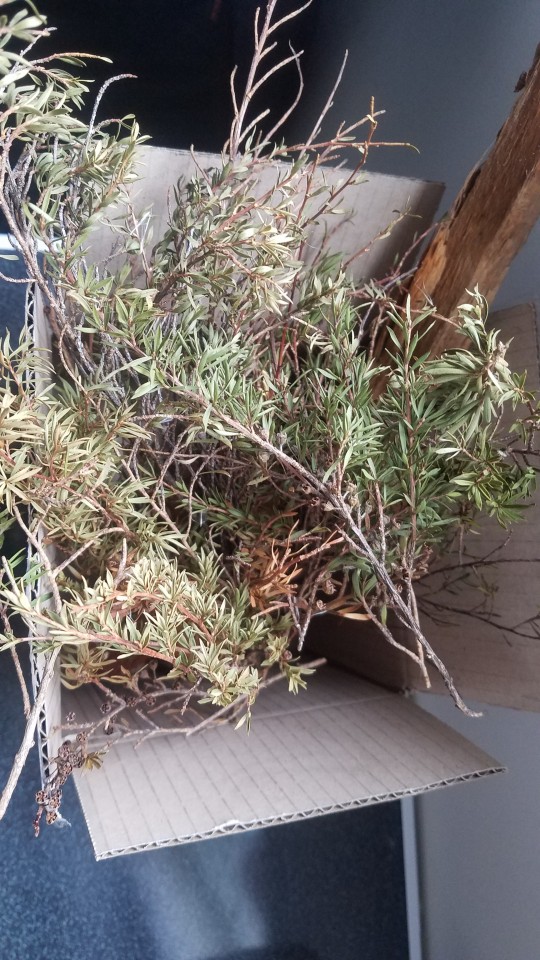
They were so indcredibly tall that I wouldn't of been able to freshly harvest the leaves if I were planning to. But I never planned to do that as I wanted to be sensitive to the plant life, as it is a reserve. To collect the teatree leaves, I foraged for fallen branches and leaves on the ground. I managed to collect a hearty bunch that I am planning to seperate and experiment with with clay and extracting fragrance.


I did some deeper research into Manūka trees only to find that the leaves that I collected might not have even been from a Manūka plant! As Manūka plant tends to appear as shrubs and their commonly mistaken sibling, the Kānuka tree appear commonly as a tree. They both are considered teatrees and both are Native to NZ, but have some distinct differences in leaves, seed capsules, size/growth, colour, bark and wether or not they have medicinal properties.
After observing the leaves and their seed capsules, as well as the fact i collected them from under a tree rather than a shrub, I can make the educated guess that the tree is a Kānuka tree. The only thing that that caused me to feel doubtful was the fact that the leaves felt very prickly (a very disticntive identifyer of the Manūka plant), but this was most likely a result of the leaves drying out after falling off the tree.
This was quite an interesting discovery as my ideas were based around the iconic Manūka tree stump John Goodall had discovered, and it made me wonder if he misclassified it as it had a stump diametere of 10-15ft (3-4m) which is more in-line with a Kānuka tree than a Manūka plant?



Another cool thing I noticed and thought I might mention, is the baby Kānuka trees that were planted in the reserve, most probably as apart of a restoration or regenerative project(refer to research i did), as there is a lot of felling and various projects happening within the reserve.
1 note
·
View note
Text

Fat Kereru
The fat part is obvious really and so inherent to kereru that it can't really be used as a descriptor. They also during some times of the year do great big swoops over the trees to show off to potential mates, and at other times get so drunk on fermenting fruit that they fall under the trees and lie out on the lawn with mates.
#my art#art#fat kereru#kereru#native birds#aotearoa#new zealand#flora and fauna#puriri#image is a bit saturated#2019
64 notes
·
View notes
Text

1 note
·
View note
Text

Pepeketua / Archey’s frog with froglets.

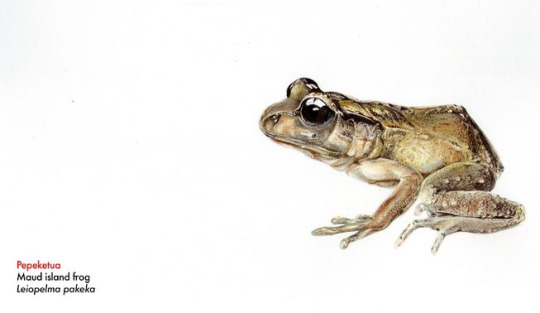
[Susan Strongman:] Whether it be the ground dwelling bats, male frogs that carry babies on their backs or parasitic plants with wooden flowers, artist Erin Forsyth has always loved everything about New Zealand’s native ngahere (bush). Forsyth’s delicate works in her [...] [2017] show [...] depict threatened native fauna and flora. [...] Talk us through some of your works on display:
[Erin Forsyth:] The pepeketua (native frogs) included are all endemic, not found anywhere else on earth. There are four species, all of which are in the Leiopelma genus. A further three species of pepeketua were documented, but have become extinct since European arrival.
Pepketua have evolved very little since Gondwanaland, having few natural predators to avoid, and are so-called ‘living fossils’ from another time. They have several unique characteristics: round (rather than slit) eyes, they do not croak regularly (if you hear a frog in Aotearoa it is an introduced species), they have no outer eardrum, and they do not have a tadpole stage - but hatch as formed froglets, which are transported by the male, riding on his back! [...]
The Archey’s frog (L. archeyi) is number one on the EDGE species list – Evolutionarily Distinct and Globally Endangered, while the Hamilton’s frog (L. hamiltoni) is one of the rarest in the world with a population estimated somewhere below 300 individuals. [...]

Myrtle rust is a fungal infection, which damages and kills plants in the family Myrtaceae. It was discovered in Aotearoa for the first time in May 2017 and it is spreading. Myrtle rust may have devastating effects on endemic species including pohutukawa, rata and manuka, some of which are already endangered [...].


[Word of Erin Forsyth. Caption reads:] [D]etails of ‘Tahi, Rau, Mokomoko - One, 100 Lizards’ acrylic on board. [...] [T]here are over 99 recognised species of native lizard (which the title alludes to) and more yet to be classified. Of those over 50% are threatened and at risk of extinction due to habitat destruction/degradation and predation (the main threats to most native fauna). The native species are gecko or skink (Tuatara are not lizards they are the last remaining Sphenodon spp.). One species from each genus of gecko is represented in this work along with several skink species. Most are geographically isolated so wouldn’t naturally be found together. Here they are seen on a twisting vine of Akapukaea (Tecomanthe speciosa) of which there has only ever been one plant found in the wild. [...].
-------
Erin Forsyth, interviewed by Susan Strongman. “Artist Erin Forsyth wants you to care.” RNZ: The Wireless. 18 October 2017. All art and photos by Erin Forsyth.
44 notes
·
View notes
Photo
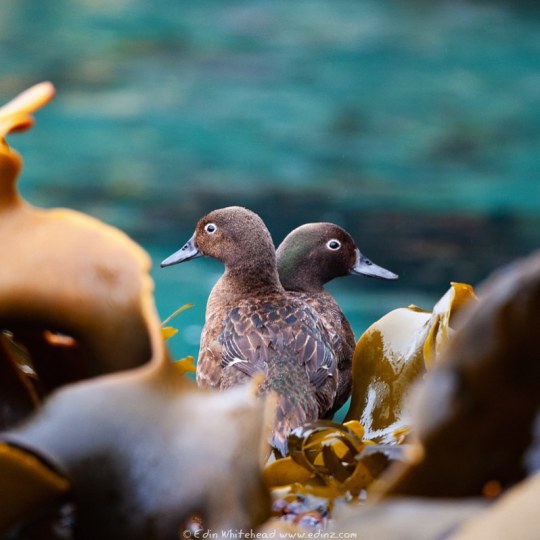
Auckland Island flightless teal are a species that will really benefit from the eradication of pigs, cats and mice from the main Auckland island (Maukahuka) the only one in Aotearoa’s subantarctic region that still has introduced mammals. The teal are endemic to the islands and are commonly seen on Enderby, which is pest free and a haven for all of the endemic species in the group. The Maukahuka project is on track to make the main island safe for all of these species again by removing the mammals that are ravaging the island, destroying both the native flora and fauna that makes it unique. ⠀ ⠀ #predatorfreenz #conservationphotography #wildlifeconservation #predatorfree2050 #birdventurenz #birdventure #subantarctic #aotearoa #wildnz #nzbirds #birdlife_insta #your_best_birds #nuts_about_birds #bird_lovers_daily #bird_brilliance #birds_adored #threatenedspecies #islandlife #nikonnz #maukahuka https://www.instagram.com/p/B7_vPCnJSnA/?igshid=ba68axx3ki76
#predatorfreenz#conservationphotography#wildlifeconservation#predatorfree2050#birdventurenz#birdventure#subantarctic#aotearoa#wildnz#nzbirds#birdlife_insta#your_best_birds#nuts_about_birds#bird_lovers_daily#bird_brilliance#birds_adored#threatenedspecies#islandlife#nikonnz#maukahuka
64 notes
·
View notes
Photo

Seza Gazette #1 Welcome to Seza Gazette. A journal entry every Friday from our atelier where we openly converse with you our patrons about our current initiatives, behind the scenes experiences, upcoming exclusive interviews and announce collaborations with artisans and creatives alike. We are here to establish a flourishing, conscious community; to bring people, brands, concepts and philosophies together into discourse and see where it takes us. For our first Gazette entry, we want to talk about trees. A brief overview of our bewildering flora, 80% of our trees, ferns and flowering plants are endemic (found only in Aotearoa/New Zealand). Our unique native trees such as the Kōwhai, Pōhutukawa, Kauri and Tī Kōuka to name a few are a national jewel with which we take pride in and celebrate their ancestral connections to the whenua. As creators of refined design, we are aware that every line drawn on paper is something taken from the earth. We ignited a spark setting in motion the drive to be unlike any other brand in our industry by voluntary planting the future. We made a promise to ourselves. For every bespoke masterpiece and every creation purchased, we donate a tree on your behalf. In doing so, you’re protecting our unique flora and fauna for future generations and are helping in diversifying our forests with iconic native planting all of which is helping reduce CO2 emissions. Seza has partnered with local initiatives to rejuvenate and preserve our air. We’re working with @treesthatcount, Project Crimson, @waihekeresourcestrust, Sustainable Paremoremo Group and others to mitigate our carbon footprint over the next 50 years, and help protect our threatened biodiversity. We have since funded 19 native trees through Trees That Countand are seeking to absorb 4.2 tonnes of CO2 emissions as those trees continue to grow but also are providing a home and habitat for all our native wildlife. Our most precious jewel is our planet and Seza will be her custodian. You can track our planting progress here https://grow.treesthatcount.co.nz/funders/seza#plantings (at Auckland, New Zealand) https://www.instagram.com/p/CbyQofkBJmm/?utm_medium=tumblr
0 notes